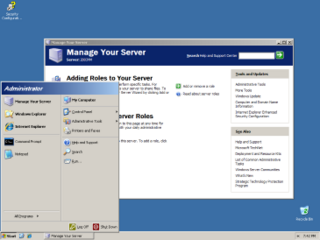
Internet Explorer was a series of graphical web browsers developed by Microsoft and included in the Microsoft Windows line of operating systems, starting in 1995. It was first released as part of the add-on package Plus! for Windows 95 that year. Later versions were available as free downloads, or in service packs, and included in the original equipment manufacturer (OEM) service releases of Windows 95 and later versions of Windows. The browser is discontinued, but still maintained.

Netscape Navigator was a proprietary web browser, and the original browser of the Netscape line, from versions 1 to 4.08, and 9.x. It was the flagship product of the Netscape Communications Corp and was the dominant web browser in terms of usage share in the 1990s, but by 2002 its use had almost disappeared. This was primarily due to the increased use of Microsoft's Internet Explorer web browser software, and partly because the Netscape Corporation did not sustain Netscape Navigator's technical innovation in the late 1990s.
Netscape is a brand name associated with the development of the Netscape web browser. It is now owned by Verizon Media, a subsidiary of Verizon. The brand belonged to the Netscape Communications Corporation, an independent American computer services company, whose headquarters were in Mountain View, California, and later Dulles, Virginia. The browser was once dominant but lost to Internet Explorer and other competitors after the so-called first browser war, its market share falling from more than 90 percent in the mid-1990s to less than 1 percent in 2006.

ActiveX is a software framework created by Microsoft that adapts its earlier Component Object Model (COM) and Object Linking and Embedding (OLE) technologies for content downloaded from a network, particularly from the World Wide Web. Microsoft introduced ActiveX in 1996. In principle, ActiveX is not dependent on Microsoft Windows operating systems, but in practice, most ActiveX controls only run on Windows. Most also require the client to be running on an x86-based computer because ActiveX controls contain compiled code.

A virtual private network (VPN) extends a private network across a public network, and enables users to send and receive data across shared or public networks as if their computing devices were directly connected to the private network. Applications running on a computing device, e.g. a laptop, desktop, smartphone, across a VPN may therefore benefit from the functionality, security, and management of the private network. Encryption is a common though not an inherent part of a VPN connection.
In computer networking, Server Message Block (SMB), one version of which was also known as Common Internet File System, operates as an application-layer or presentation-layer network protocol mainly used for providing shared access to files, printers, and serial ports and miscellaneous communications between nodes on a network. It also provides an authenticated inter-process communication mechanism. Most usage of SMB involves computers running Microsoft Windows, where it was known as "Microsoft Windows Network" before the introduction of Active Directory. Corresponding Windows services are LAN Manager Server and LAN Manager Workstation.

A browser war is competition for dominance in the usage share of web browsers. The "First Browser War" during the late 1990s pitted Microsoft's Internet Explorer against Netscape's Navigator. Browser wars continued with the decline of Internet Explorer's market share and the popularity of other browsers including Firefox, Google Chrome, Safari, and Opera.
Spyglass, Inc., was an Internet software company based in Champaign, Illinois.
The Web Proxy Auto-Discovery Protocol (WPAD) is a method used by clients to locate the URL of a configuration file using DHCP and/or DNS discovery methods. Once detection and download of the configuration file is complete, it can be executed to determine the proxy for a specified URL.

The following tables compare general and technical information for a number of web browsers.

Internet Explorer for Mac OS X is an unsupported inactive proprietary web browser developed by Microsoft for the Macintosh platform. Initial versions were developed from the same code base as Internet Explorer for Windows. Later versions diverged, particularly with the release of version 5 which included the cutting edge, fault-tolerant and highly standards-compliant Tasman layout engine.

Netscape Browser is the eighth major release of the Netscape series of web browsers, now all discontinued. It was published by AOL, but developed by Mercurial Communications, and originally released for Windows on May 19, 2005.
about is an internal URI scheme implemented in various Web browsers to reveal internal state and built-in functions. It is an IANA officially registered scheme, and is standardized.

Windows Internet Explorer 7 (IE7) is a web browser for Windows. It was released by Microsoft in October 2006. Internet Explorer 7 is part of a long line of versions of Internet Explorer and was the first major update to the browser in more than 5 years. It is the default browser in Windows Vista and Windows Server 2008 and can replace Internet Explorer 6 on Windows XP and Windows Server 2003 but unlike version 6, this version does not support Windows NT 4.0, Windows 98, Windows 98 SE, Windows 2000, and Windows ME.
Netscape Plugin Application Programming Interface (NPAPI) is a deprecated application programming interface (API) that allows browser extensions to be developed. It was first developed for Netscape browsers, starting in 1995 with Netscape Navigator 2.0, but was subsequently adopted by other browsers. With the advent of HTML5 many software vendors have removed support for this API for security reasons.

Microsoft Internet Explorer 5 (IE5) is a graphical web browser and one of the main participants of the first browser war. Its distribution methods and Windows integration were involved in the United States v. Microsoft Corp. case. It is included with Windows 98 SE and Windows ME and it is the last version of Internet Explorer for Windows 3.1x, Windows NT 3.x and Windows 95. Although Internet Explorer 5 ran only on Windows, its siblings Internet Explorer for Mac 5 and Internet Explorer for UNIX 5 supported Mac OS X, Solaris and HP-UX.

Microsoft Internet Explorer 3 (IE3) is a graphical web browser released on August 13, 1996 by Microsoft for Microsoft Windows and on January 8, 1997 for Apple Mac OS. It began serious competition against Netscape Navigator in the first Browser war. It was Microsoft's first browser release with a major internal development component. It was the first more widely used version of Internet Explorer, although it did not surpass Netscape or become the browser with the most market share. During its tenure, IE market share went from roughly 3–9% in early 1996 to 20–30% by the end of 1997. In September 1997 it was superseded by Microsoft Internet Explorer 4.

Microsoft Internet Explorer 2 (IE2) is the second major version of Internet Explorer (IE), a graphical web browser by Microsoft. It was released on November 22, 1995, for Windows 95 and Windows NT, and on April 23, 1996, for Apple Macintosh and Windows 3.1.

Internet Explorer 11 (IE11) is the eleventh and final version of the Internet Explorer web browser by Microsoft. It was officially released on October 17, 2013 for Windows 8.1 and on November 7, 2013 for Windows 7. The browser was also shipped with Windows 10 on its release on July 29, 2015, but Microsoft Edge is the default browser in this version of Windows. It is the default browser shipped with Windows Server 2016 and Windows Server 2019. After January 12, 2016, only the most recent version of Internet Explorer to be offered for installation on any given Windows operating system will continue to be supported with security updates, lasting until the end of the support lifecycle for that Windows operating system. On Windows 7, 8.1, and 10, only Internet Explorer 11 will receive security updates for the remainder of those Windows versions' support lifecycles.












